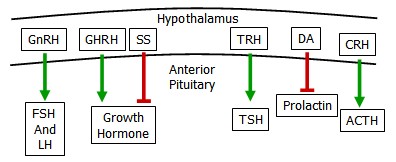
Hypothalamus
last authored:
last reviewed:
Introduction
The hypothalamus is the body's main sensor and responder of environmental conditions, affecting behaviour through neuroendocrine mechanisms.
The hypothalamus is a collection of nuclei. It is involved in autonomic functioning and homeostasis, including temperature, blood pressure, fluid and salt balance.
Hypothalamic output occurs via two mechanisms:
- neural pathways (tracts)
- neuroendocrine, especially in relation to the pituitary using axonal transport of hormones through the hypophysis
It is a small region in the forebrain, being continuous with the periacqueductal gray in the brainstem midbrain.
The hypothalamus is a key regulator of the endocrine system, monitoring the pituitary gland (the master gland of the body) and producing hormones to control it.
Along with this endocrine role, it monitors internal environment conditions such as water and salt balance, temperature, and carbohydrate metabolism.
The invloved hypothalamic cells are called neuroendocrine cells becuase they release nerve impulses and release hormones into the portal vessels of the posterior pituitary.

Releasing hormones stimulate release from the anterior pituitary, while inhibiting hormones suppress release.
- Corticotropin-releasing hormone, or CRH, is released from the hypothalamus in response to physical, emotional, or biochemical stress, and in response to diurnal rhythms. It causes ACTH release from the pituitary.
- TRH regulates release of TSH in the anterior pituitary
- gonadotropin-releasing hormone (GnRH) causes release of LH and FSH
- dopamine inhibits prolactin release
- growth hormone-releasing hormone (GHRH) causes release of growth hormone from the anterior pituitary, while somatostatin inhibits it
The hypothalamus has a significant role in mediating the autonomic nervous system through strong, direct connections with autonomic nuclei in the brian stem and spinal cord.
Suprachiasmatic nucleus
The SCN is the master clock for circadian rhythms.
Connections
Inputs from brainstem, spinal cord, cerebellum, basal ganglia, and limbic structures.
Outputs to limbic structures, pituitary, reflexes and motor programs, and autonomic motor neurons.
Mammilothalamic tract passes from the mammilary body to the anterior nucleus of the thalamus
Homeostasis
Visceral Activity
